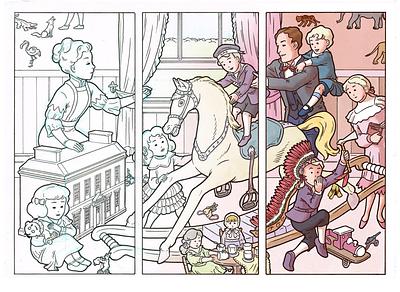You’ve got an idea, you’ve got a story, you’ve got a main character - you’re ready to go. But how to you make sure your comic looks as good as it should? Here are a few top tips for getting your head around drawing a brilliant comic.
Give your characters something special
It doesn’t matter whether you have two characters or 100, you need to find a way to make the important people in your comic stand out. And the easiest way to do that is to give them an exciting, noticeable look.
When you're adapting from a novel, check to see if there're any strong descriptions of the characters to help you. Some people like to be loyal to the original author's description, and some people like to reinvent characters their own way; I think it's up to you!
Maybe your main character always wears a hat. Maybe they only ever dress in red. Maybe they have a pet lizard that sits on their shoulder or sparks come out of their hair! Anything goes, as long as your reader will always recognise them, even in a crowd.
Use your colours to change scenes and places
There’s a good chance the action in your comic will take place over a couple of different locations at a few different times. It might start in a queue to see a movie and end in outer space! So how do you show when you’ve moved from one time/place to another?
This is where colour is your best friend. You can use it to separate scenes in the reader’s minds and give everything a distinct look. So for a daytime outside scene, you’d want blue skies and bright colours. In a house, you might give everything a pink, warm glow. At night, take all the colours down a notch into deep blue or purple (but avoid using too much black!).
Pick the right spots for speech bubbles
Not all comics have speech bubbles – some comics have no words at all! – but if you’re planning on adding dialogue, narration or interior monologues to your story you need to have a think about where your words will go on the page.
A really common mistake for new comic artists is to pack their panels with pictures, leaving no room for speech. Avoid this easy mistake by marking out space for bubbles before you start drawing. Normally, it’s easiest to put speech at the top or bottom of a panel, keep the bubble close to the character who's speaking - and be sure to point the speech bubble's tail toward their mouth.
Make page turns exciting
One of the best and most unique things about comics is the fact that you can control when people see what’s coming next by putting exciting moments after the turn of a page. This is the perfect moment for changing scene or location and it’s also an excellent time to add in a little cliff hanger – so your reader really wants to see what’s about to happen next.
For really big moments, surprises or a twist, have your page end on a dramatic note and turn into a splash page (that’s a page that has a big image rather than lots of panels, so you can really highlight the action).
Give yourself space to practice
Drawing a comic is loads and loads of fun but we all know that sometimes that blank page can be a bit frightening. What if you get the costume of your main character wrong? Or their face goes wonky? Or you have an accident with your paints and the whole thing is ruined?
Don’t panic. Instead, make good use of any scanners, photocopiers or tracing paper you have access to. If you can scan or photocopy your pencil drawings, you can work on a copy to try experiments, add darker lines, put in the finishing touches and go wild with colour - without worrying about ruining your original drawing.
The illustration is a series of panels from J. M. Barrie's Peter Pan: The Graphic Novel, drawn by Stephen White and coloured by Fin.

